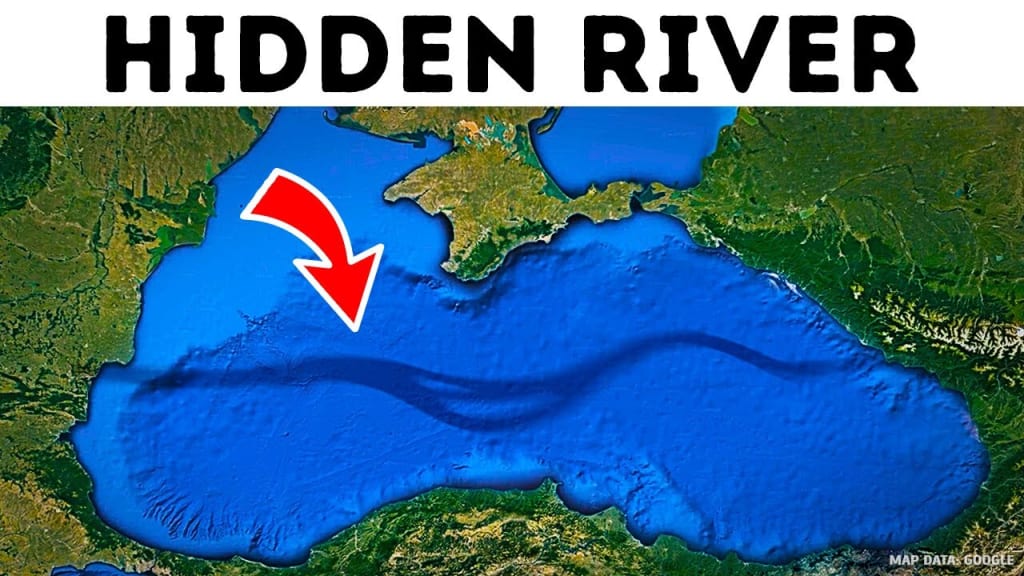Huge River Under Black Sea
A significant discovery was made by scientists beneath the Black Sea—a massive river was found.

Let's engage in a guessing game. Can you identify the sixth largest river on Earth in terms of volume? This refers to the amount of water that flows through a waterway. While it may be easy to list the top rivers like the Amazon, Congo, and Ganges, this particular river is not found on the surface. Instead, it exists beneath the waves of the Black Sea. In 2010, scientists discovered this underwater river while studying the Bosphorus Strait in Turkey using sonar scanning. The river-like channel at the bottom of the Black Sea was found to have water flowing through it, with depths reaching up to 115 feet, which is three times the height of an average telephone pole. Its volume is even 350 times greater than that of the River Thames in London. This underwater river displays characteristics of a real river, including rapids and waterfalls, despite being concealed beneath the sea.
The formation of this underwater river can be attributed to the unique features of the Black Sea. The sea receives water from two primary sources: freshwater rivers such as the Danube, Dnieper, and Don, and the saltwater Mediterranean Sea. When the saltwater enters the Black Sea, it sinks to the bottom due to its higher density compared to freshwater. This leads to stratification, where the two types of water do not mix. The upper layer of water in the Black Sea is rich in oxygen, allowing it to support life, while the bottom layer is anoxic, meaning it lacks oxygen. This anoxic condition is actually beneficial for the preservation of shipwrecks, as oxygen would decompose wood. Consequently, shipwrecks in the Black Sea can survive for centuries, providing valuable historical artifacts for researchers.
In 2018, scientists discovered the world's oldest Greek shipwreck in the Black Sea, estimated to be 2,400 years old. The wreckage remains remarkably intact, offering insights into ancient ship construction. The depth of the Black Sea, which reaches around 7,257 feet at its deepest point, contributes to the preservation of these submerged relics.
Underwater rivers and shipwrecks are not exclusive to the Black Sea. Off the coast of South America, a large channel exists along the ocean floor, extending from the mouth of the Amazon River into the Atlantic Ocean. However, studying underwater rivers presents challenges due to their depth and strong currents, making it difficult for divers to explore. Specialized equipment, like remotely operated vehicles (ROVs), is often used for underwater research in such environments.
Additionally, there are natural formations called cenotes, which are underground caves found primarily in the Yucatan Peninsula in Mexico. These cenotes, associated with the Mayan civilization, served as water sources and were considered sacred. Researchers have identified around 10,000 cenotes across the Yucatan Peninsula, as well as in other locations like Cuba and Australia.
One of the most renowned cenotes, Cenote Angelita, located south of Tulum in Mexico, is particularly captivating. Divers can explore this cenote using scuba gear, revealing an underwater river with trees along its banks. However, what appears to be a river is actually a thick layer of fog formed by hydrogen sulfates, which creates the illusion of flowing water.
There are also examples of rivers that flow underground, such as the Mystery River in Indiana, which is the longest underground river in the United States. Blue Spring caverns in Indiana's Cave System allow visitors to take boat tours along this hidden river. The Saraswati River in India adds to the mystique of underground rivers. While ancient literature mentioned this river, it was considered a myth until satellite images suggested its existence. Although it was believed to have dried up, further research revealed that the Saraswati River flows underground, approximately 200 feet below the ground. Local experts believe that the river continues to slowly flow into the sea.
Cities like London and New York also have underground rivers, albeit influenced by human activity. These rivers now flow beneath the surface, and while they may no longer be visible, they remain present in old maps and street names.
In conclusion, the world is full of fascinating phenomena, including underwater rivers and hidden shipwrecks. If you found this information intriguing, consider liking and sharing the video with your friends. To continue exploring captivating content, click on the suggested videos and stay curious.





Comments
Mela Mandigma is not accepting comments at the moment
Want to show your support? Send them a one-off tip.